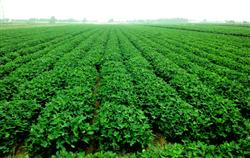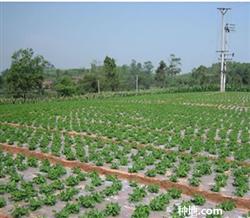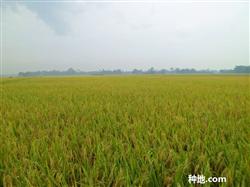How can spring peanuts be planted with high yield?

How can spring peanuts be planted with high yield? Spring planting peanut is a kind of main cash crop in our province, with large planting area, high and unbalanced yield, still many medium-and low-yield fields and great potential to increase production. For high yield of spring peanut, six technical links must be mastered: first, select excellent varieties. Improved varieties are the basis for high yield, and varieties with strong resistance, high yield and high oil should be used first. Experiments in recent years show that "three high" varieties such as Shanyou 523, Shanyou 71 and Yueyou 79 are worth popularizing. When planting, pods and kernels should be selected again, and pods and kernels that are full, disease-free and insect-free must be selected. Second, cultivate excellent soil fertility. In order to cultivate deep, soft and loose soil environment in spring peanut field, we should mainly pay attention to two aspects: one is fine soil preparation, raking and leveling, and the other is increasing the application of organic matter fertilizer. When preparing the soil, apply high-quality soil fertilizer and fence fertilizer 800Mu 1000kg, phosphate fertilizer 25MIT 30kg, potassium chloride 10kg, plant ash 2Mol 3 piculs, and spread the whole layer in the soil. Third, sow seeds early at the right time. Spring peanuts should be sowed early, and the best time is before and after "Rain Water" to "sting". When the temperature rises above 20 ℃, it can be planted. Fourth, appropriately increase the number of plants. Properly increase the sowing rate and individual plant, coordinate the contradiction between individual and population development, and carry out reasonable close planting on the principle of making full use of soil fertility and light energy. Generally, it is appropriate to sow 20,000 plants per mu, using 1.4-1.5 meters to cover the furrow and arch border, paddy field should be high border (dry garden can be low border), plant row spacing is 18 × 23 cm, hole sowing 2 grains (2 Mel 3 cm), covering soil 2 Mel 3 cm. Fifth, strengthen scientific management. Take good care of spring peanuts and focus on four aspects: ① application of herbicides. A few days before emergence, 100m / mu of herbicides such as "du'er" were sprayed evenly on the soil to moisturize the soil with 100m / u of 125g and 100kg of water; ② topdressing was timely, with emphasis on three-leaf fertilizer, seven-leaf fertilizer and foliar fertilizer. Urea 4m 5kg per mu was used, mixed water and fertilizer was applied to the plants, and black (white) lime 20kg / mu was applied to 30kg / mu at the first flowering stage. In the pod-setting period, 80ml 100g of potassium dihydrogen phosphate and 250g of urea were mixed with 80kg water. Spraying foliar twice, ③ timely loosening soil, loosening soil can eliminate weeds, reduce soil water evaporation and facilitate soil ventilation. Generally speaking, loosen the soil twice, loosen the soil at the initial tillering stage and full tillering stage, shallow soil cultivation and re-cultivation soil at the first and second flowering stage, respectively; ④ reasonable drainage and irrigation. Peanuts like to be wet and afraid of drought and stains. When planting, the soil should be moderately moist and well watered to promote rapid emergence and full seedling. During tillering and flowering and fruiting period, appropriate amount of water should be irrigated and moisturized in time in case of drought so as to promote branches and full fruit. If there is stagnant water in rainy days, it should be drained in time to prevent stains. From the middle stage of growth, the drainage ditch should be deepened, and the central ditch should be opened in the field to reduce the groundwater level and facilitate drainage and waterlogging prevention. Sixth, timely disinfestation and disease prevention. Control aphids and thrips in the early stage, and mainly control Spodoptera litura, rust and leaf spot in the middle stage. The pest can be sprayed with 100g / mu of trichlorfon and 80kg of water, and the disease can be sprayed with chlorothalonil and Bordeaux solution, which should be sprayed more than twice. Click to get more peanut planting technology click to get more grain and oil crop planting technology
- Prev

How to cultivate peanuts covered with plastic film?
How to cultivate peanuts covered with plastic film? Method 1, preparation before sowing 1, seed selection: 91028908 to flowers, drying fruit: drying fruit before peeling kernels, drying fruit 2 for 3 days 3, film preparation: buying 60 cm microfilm, 4 kg per mu, 4 kg per mu, underground pest control: ① uses methyl isomaliphate or phoxim 3 min 4 per mu with 0.5 water.
- Next

How to fertilize hybrid rice scientifically?
How to fertilize hybrid rice scientifically? The fertilization principle of hybrid rice should be organic fertilizer and phosphorus fertilizer as base fertilizer, potassium fertilizer as tiller fertilizer, nitrogen fertilizer applied evenly for many times, pay special attention to strong bud and strong seed fertilizer, attack large panicle and large grain at the same time. (1) the base fertilizer is mainly organic fertilizer.
Related
- The first cup of black tea in spring, the flavor and history of tea gardens in Kenya, Africa
- The computer can not only choose potatoes, but also grow tea rice. AI will grow winter oolong tea champion.
- It is not only the inflated tea bitten by insects, but also engraved with the four seasons tea in Beipu.
- The Oriental Beauty Tea Festival in Zhuxian County takes the stage at the weekend to experience the plus-size feast of oil tea.
- & quot; Oriental Beauty Tea & Exploration of Emei in Hsinchu, the hometown of quot;
- The new variety of strawberry "Tainong 1" dessert is the first choice with mellow aroma. Crimson gorgeous
- History of Tea in Taiwan: from Wild Inner Mountain to Export Tea Garden
- Two types of Taiwan Oriental Beauty Black Tea won the British three-Star Award for Childhood Tea Xiang Zhang Jiaqi changed from pilot to champion tea maker.
- Banana species and varieties: the planting history of Taiwan Xianren banana and dwarf banana is long, is banana disease resistant?
- Coffee planting Technology: Qianjie Coffee from Seedling to harvesting

